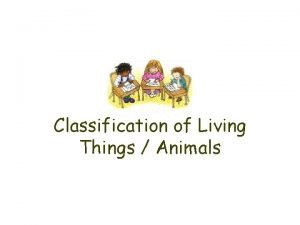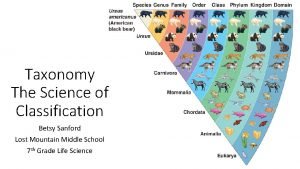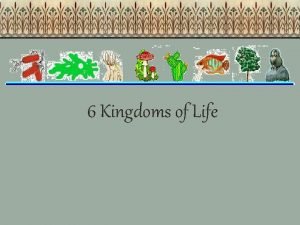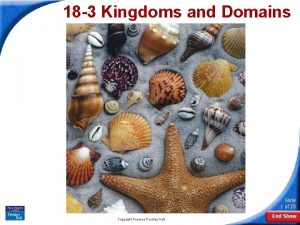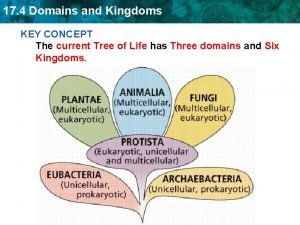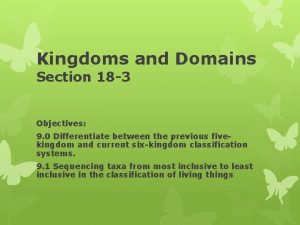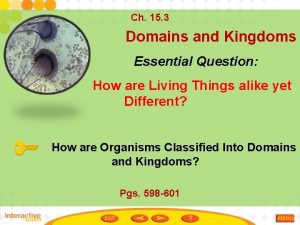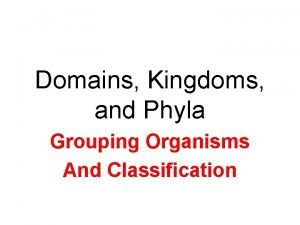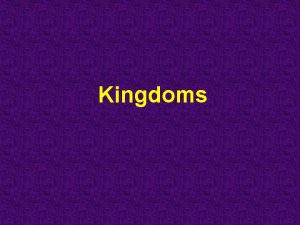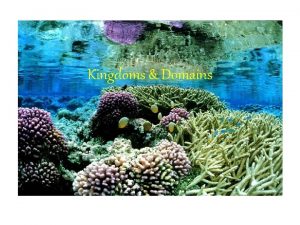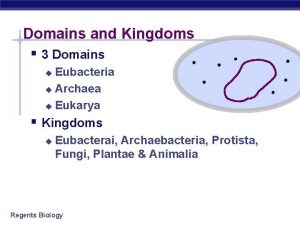Domains and Kingdoms Spring 2018 Classification of Living














- Slides: 14

Domains and Kingdoms Spring 2018

Classification of Living Things ▪ Organisms are placed into domains and kingdoms based on their: ▪ Cell type ▪ Their ability to make food ▪ The number of cells that make up their bodies

Make a Chart That Looks Like This: Leave a lot of space to write. Take up your entire page. Domain Kingdom Cell Type Cell Structures Number of Cells Mode of Nutrition Examples Bacteria Archaea Eukarya

Bacteria ▪ Domain ▪ Bacteria ▪ Kingdom ▪ Eubacteria ▪ Cell Type ▪ Prokaryote ▪ Cell Structures ▪ Cell walls with peptidoglycan ▪ Number of Cells ▪ Unicellular ▪ Mode of Nutrition ▪ Autotroph or Heterotroph ▪ Examples: ▪ E. Coli ▪ Streptococcus pneumoniae ▪ Salmonella Enteritidis ▪ Listeriamonocytogenes

Peptidoglycan ▪ The peptidoglycan layer in the bacterial cell wall is a crystal lattice structure formed from linear chains of two alternating amino sugars.

Archaea ▪ Domain ▪ Archaea ▪ Kingdom ▪ Archaebacteria ▪ Cell Type ▪ Prokaryote ▪ Cell Structures ▪ Cell walls without peptidoglycan ▪ Number of Cells ▪ Unicellular ▪ Mode of Nutrition ▪ Autotroph or Heterotroph ▪ Examples ▪ Halophiles

Halophile

Eukarya ▪ Domain ▪ Eukarya ▪ Kingdom ▪ Protista ▪ Cell Type ▪ Eukaryote ▪ Cell Structures ▪ Some cell walls made of glucose ▪ Some made of chloroplasts ▪ Number of Cells ▪ Most unicellular ▪ Some colonial ▪ Some multicellular ▪ Mode of Nutrition ▪ Autotroph or Heterotroph ▪ Examples: ▪ Amoeba ▪ Slime Molds

Amoeba

Eukarya ▪ Domain ▪ Eukarya ▪ Kingdom ▪ Fungi ▪ Cell Type ▪ Eukaryote ▪ Cell Structures ▪ Cell walls of chitin ▪ Number of Cells ▪ Most Multicellular ▪ Some unicellular ▪ Mode of Nutrition ▪ Heterotroph ▪ Examples ▪ Mushrooms ▪ Yeasts

Yeast

Eukarya ▪ Domain ▪ Eukarya ▪ Kingdom ▪ Plantae ▪ Cell Type ▪ Eukaryote ▪ Cell Structures ▪ Cell walls of cellulose ▪ Chloroplasts ▪ Number of Cells ▪ Most multicellular ▪ Some green algae are unicellular ▪ Mode of Nutrition ▪ Autotroph ▪ Examples ▪ Mosses ▪ Ferns ▪ Flowering Plants

Eukarya ▪ Domain ▪ Eukarya ▪ Kingdom ▪ Animalia ▪ Cell Type ▪ Eukaryote ▪ Cell Structures ▪ NO cell walls or chloroplasts ▪ Number of Cells ▪ Multicellular ▪ Mode of Nutrition ▪ Heterotroph ▪ Examples ▪ Sponges ▪ Worms ▪ Insects ▪ Fish ▪ Mammals

Done!
 Which kingdoms include only prokaryotes
Which kingdoms include only prokaryotes Invertebrates animals
Invertebrates animals Classification study guide answer key
Classification study guide answer key Bacteria kingdom characteristics
Bacteria kingdom characteristics Chapter 17 domains and kingdoms
Chapter 17 domains and kingdoms Chapter 17 section 1 the history of classification
Chapter 17 section 1 the history of classification Six kingdoms of life
Six kingdoms of life Section 18-3 kingdoms and domains
Section 18-3 kingdoms and domains Chapter 17 section 3 domains and kingdoms
Chapter 17 section 3 domains and kingdoms Section 18-3 kingdoms and domains
Section 18-3 kingdoms and domains Flow chart of domains and kingdoms
Flow chart of domains and kingdoms How are organisms classified into domains and kingdoms
How are organisms classified into domains and kingdoms Eubacteria examples with scientific names
Eubacteria examples with scientific names What are the three domains and six kingdoms?
What are the three domains and six kingdoms? Domains and kingdoms
Domains and kingdoms

